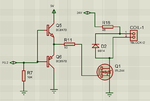gauravkothari23
Advanced Member level 2

- Joined
- Mar 21, 2015
- Messages
- 644
- Helped
- 5
- Reputation
- 10
- Reaction score
- 4
- Trophy points
- 1,298
- Activity points
- 6,951
The schematic is OK although I would add a resistor in series with the input. Your problem is the 11N60DM2 which needs as much as 5V on its gate before it STARTS conducting. Ideally you want far more than that to ensure it turns full on .
The simplest modification I can think of is to connect Q5 collector and R2 to 24V and add another transistor at the input to drive Q5 and Q6.
Brian.
I have made a small testing.
i tried switching Mosfet ON and OFF after every delay of 2 seconds to check if i am getting the proper output.
but yes, i am getting the proper output of 24V and 0V after every 2 seconds. so why when i switch it faster at 300Khz, the mosfet is not getting OFF and stays ON due to which i am getting continues 24V at the output.







